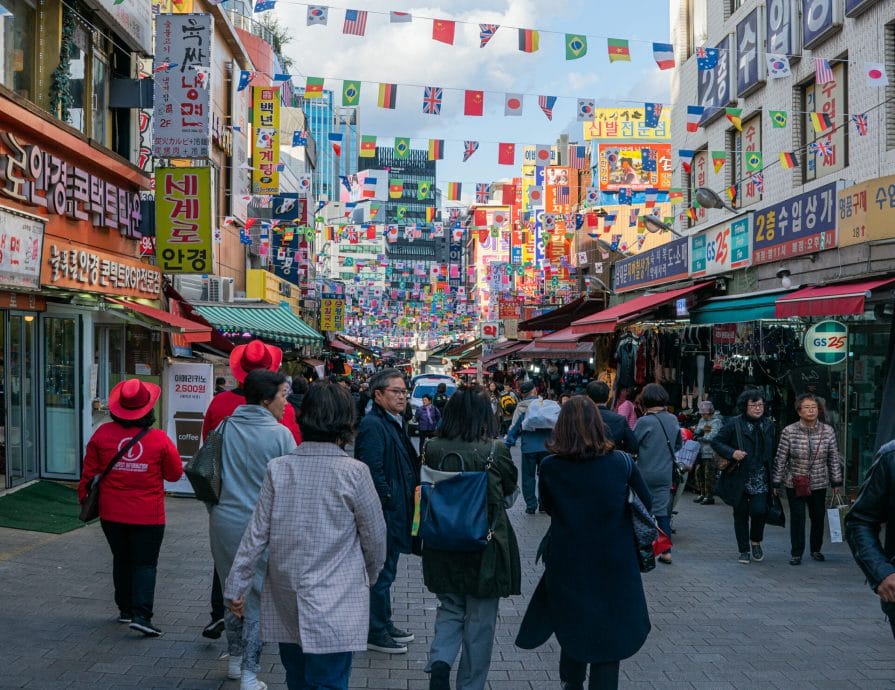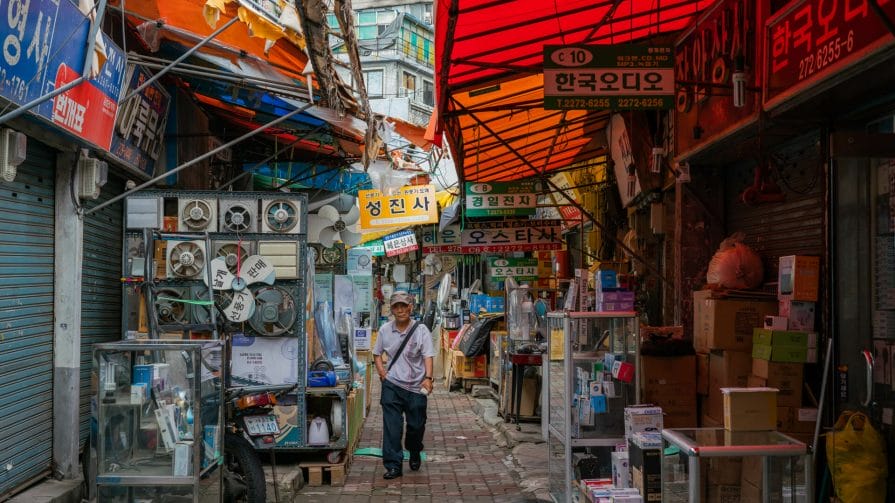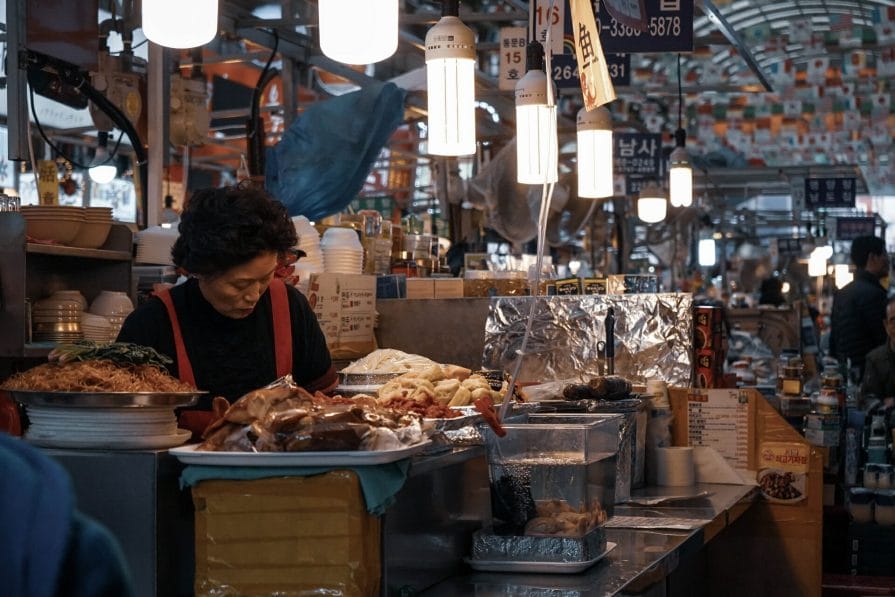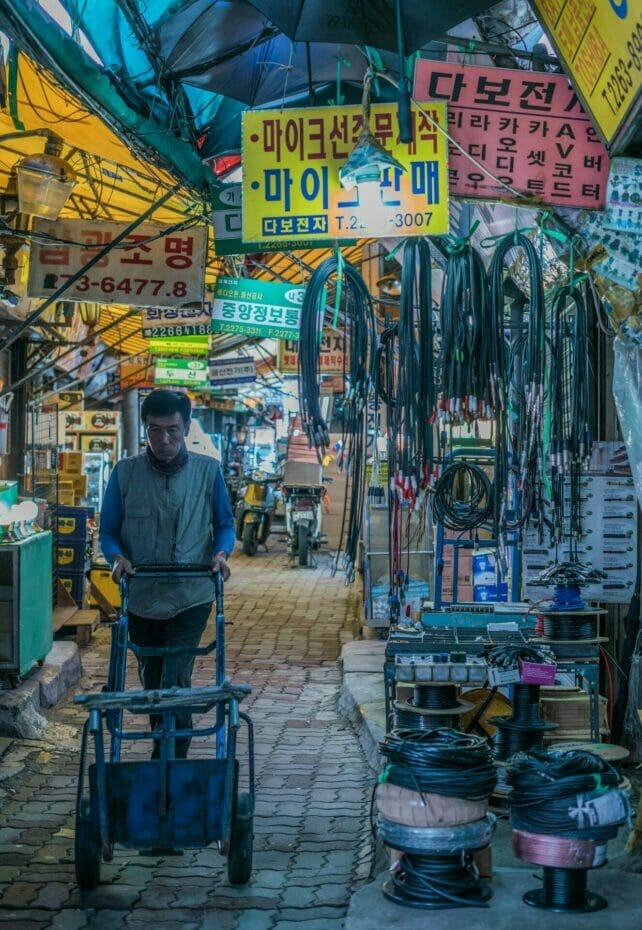Why Gwangjang Market is Seoul’s Best Market

If you want to experience the markets of Seoul, but you are also someone who likes an adventure, then add Gwangjang Market to your bucket list right now!
Gwangjang Market opened in 1905 and has over 5000 shops now, making it one of the biggest markets in Seoul. While the market may seem small at first, it really is quite sprawling – unfortunately most people will never fully explore it.
Not only this, but it is the oldest market remaining market in the city. Gwangjang is great if Namdaemun Market is too touristy for your tastes, or if Dongdaemun Market is too modernized. Although Gwangjang is becoming more tourist-focused, it still lags behind these other markets.
The market still has an element of traditional Seoul. It feels more old-fashioned and unique compared to the aforementioned markets. It is for this reason that I love Gwangjang. Although it is a bit dirtier, and a bit harder to navigate, it also feels authentic.
Quick Info
Opening Hours: Gwangjang Market hours are from 9 am until 6 pm. The food street is open until 11 pm. The food market is open every day.
Location: Gwangjang Market is located in Jongno, Seoul. Location.
Directions: To get to Gwangjang Market, simply take the subway line 1 to Jongno 5-ga Station. From there, exit from exit 8 and walk straight. You will see the gates of the market a short walk down the road.
Gwangjang Market

Gwangjang Market has a lot more than just food!
Gwangjang Market is famous for its food street. It’s an amazing place for foodies and you can find nearly any kind of Korean food imaginable there. Even better, the price of the food is very good as it is some of the cheapest in Seoul.
If you want to try Korean street food, then Gwangjang is the best one-stop shop in Seoul. Many of the street foods (meals) will start at around 5000KRW, and they will go up to 10,000KRW. Snack foods, on the other hand, are very cheap and can be found beginning at 1000KRW.
However, the market has a lot more to it than food. It’s an extremely large market and it would take hours to explore all of it! Although the front of the market is more tourist-focused and features mostly food, souvenirs and clothes, you can find virtually anything if you navigate through the market.
For example, in the picture above you can see some of the light and electronic stores that can be found all over the market. There are hundreds of them! Jewellery stores are also very common and you can find hundreds of them. These stores stock primarily Korean jewellery brands, but you can find some international brands also.
The issue with Gwangjang is that other than the front area, none of the market is very accessible for tourists. Not only is it very hard to navigate, but there is a big lack of English as many of the vendors will only speak Korean… The signs are also in Korean only.
It is for this reason that the market is left unexplored by many. While the exploration is not for everybody, I really do recommend it. It’s very safe (Korea is extremely safe) and you can uncover hidden gems within the market. Just make sure to bring cash because some of the smaller stores may not accept cards (or they will charge 10% more).
Gwangjang Market or Namdaemun Market?

Namdaemun is the most famous market in Seoul, and it’s a place that many visitors have on their bucket list. Most tourists only visit one market, and I am commonly asked which one is the better market to visit.
Of course, if you have the time, I would recommend visiting both. They have very different feelings and I don’t feel like the markets in Seoul are a case of ‘if you visit one you have visited them all’. This is especially true because each market has a speciality.
For example, Yongsan Market is famous for electronics, Dongdaemun Market is famous for clothes, Noryangjin Market is famous for fish. The list goes on. Each market is famous for something and they all unique.
However, if you are reading this section you are probably looking for a straightforward answer. You have to pick between Gwangjang and Namdaemun – which one is best?
This is actually a surprisingly easy question to answer! It depends on two main questions:
- Which kind of market do you want?
If you are looking to experience food, then Gwangjang is better. Hands down. If you want to purchase souvenirs, clothes, or other items, Namdaemun is better.
- Which kind of market do you want?
If you would prefer a very tourist-focused market with many English speaking shop owners, then Namdaemun is better. While Gwangjang is becoming more of a tourist location, it is still a much more ‘authentic’ experience. It feels a lot more real than Namdaemun.
In my mind, Gwangjang is a far better market, especially for food. I only visit Namdaemun for the camera market. Personally, I find it to be a bit crowded for my taste. It also tends to be more expensive.
How To Get to Gwangjang Market

Exploring the back streets of Gwangjang Market.
Gwangjang Market is located right outside Jongno 5-ga Station (종로5가역) and is within walking distance of exit 8. The market itself is very obvious and easy to find, and there will be both English and Korean (광장시장) markings.
Getting to the market is very straightforward using the amazing public transport in Seoul and your T-Money card. The Discover Seoul Pass is also a great option for visitors!
While buses are also available, I will just talk about the subway route here. While buses are convenient, the subway tends to be easier to understand.
How to get to Gwangjang Market from Myeongdong
You can take either the subway (line 4 – the light blue line) towards Chungmuro. Get off the train at Dongdaemun and transfer to line 1 (dark blue). Go one station towards Jongno-5(o) ga. From there, exit the station via exit 8 and walk straight until you see the market gates.
How to get Gwangjang Market from Hongdae
From Hongdae, take line 2 (green line) in Sinchon direction. Stay on the train until city hall where you need to transfer to line 1 (dark blue). Proceed three stops in Jonggak direction and exit the train at Jongno-5(o) ga station. From there, exit the station via exit 8 and walk straight until you see the market gates.
How to get to Gwangjang Market from Gangnam
From Gangnam expect to be on the train for 40 minutes – one hour. Take line 2 (green line) one station to Seoul National University of Education. From there, transfer to line 5 (orange line). Head north in Express Bus Terminal Direction and stay on the train until you reach Jongno-3(sam) ga. Transfer again to line 1 (dark blue line) and go one station to Jongno-5(o) ga.
How to get to Gwangjang Market from Dongdaemun
From Dongdaemun, you can easily walk to Gwangjang with a 20-minute walk. However, you can also take the subway one-stop on line 1 (dark blue line). Simply get on the train in Jongno-5(o) ga direction and get off and Jongno-5(o) ga. From there, exit the station via exit 8 and walk straight until you see the market gates.
Gwangjang Market Food Street

Gwangjang Market food street.
The food street is the highlight of the market for most people – with good reason. The variety and amount of food are staggering, and it’s one of the best places in Seoul to experience authentic Korean street food.
Any kind of traditional Korean food that you want to try can be found at this market. That includes kimbap, bibimbap, tteokbokki (spicy rice cakes), bindaetteok (Korean savoury pancakes), Sundae (blood sausage) and much more!
The stalls generally have small seating areas meant for 2-6 people. The expectation is that you will eat and move on (not linger), and you may notice that the staff look at you if you stay for too long.
The good news is that many of the sellers are very pleasant and friendly! A lot of them are even happy to explain how to eat the food correctly (for example, if you forget to mix your bibimbap!).
The street food varies widely in price depending on what you get. However, you can expect to get a serving of tteokbokki for around 3000KRW, and a meal of bibimbap for around 6000KRW. All-in-all, it’s quite comparable to other Korean restaurants in the city.
Food Street Tours

If you want to learn more about the food, join a food street tour!
If you are looking to learn while exploring the market then there are some great food tours available.
If you are looking for a tour that covers a few of the highlights in central Seoul, including Gwangjang, then make sure to check out this tour by Klook. It will pair you with a local guide and allow you to try some food at Gwangjang while also exploring some of the city’s other attractions!
Although some people prefer to travel and explore on their own (I am definitely one of those people), a tour can be a great educational experience if you don’t know any Koreans who can show you around. While it’s fun to eat the food, it’s even more interesting to learn about it.
Gwangjang Market Shopping Tips

If you are visiting Gwangjang Market, make sure to bring cash. While some places will accept cards, it’s far more reliable to bring cash. There are also cases where you will pay 10% more if you use a credit/debit card.
The exact amount required depends on how much you want to eat and how many people you are. However, a safe amount would be 30,000KRW or 50,000KRW for more than three people.
Make sure to look around a bit before buying. There is a LOT of food in the market, and you can get full quite quickly. Make sure to walk around the market before buying the larger dishes and you might be disappointed to miss out on something otherwise!
I would also recommend bringing some hand sanitiser. Since you will be looking around the market and possibly touching lots of things, it is definitely worth washing your hands before eating. Especially since you might be eating some food with your hands!
Exploring the Market

Gwangjang is a massive market in Seoul.
While the market is most famous for its food street, there is a lot more that most people never get to see. From wholesale fabrics to electronics and jewellery, there is a lot that can be found in the back streets of Gwangjang!
If you explore the area around the main market you will find a lot of cool little stores that give the market its true character.
Many people are worried about the safety of the market as it gets quite narrow and people may stare at you (as many foreigners don’t go to this part of the market). It is important to remember that Seoul is incredibly safe though, and these alleys are no different. If store owners stare at you then it is for no reason other than you may seem out of place.
If you are interested in photographing the market, these backstreets are the perfect place. You will come across many people living their life in the market, and that is what makes it so fascinating to explore.
Why Visit Gwangjang?

No matter which market you visit in Korea you will have a fantastic time. There are a lot of markets that each specialise in different things – Yongsan is famous for electronics, Namdaemun for cameras, Noryangjin for fish – to name only a few.
What makes Gwangjang unique and worth visiting is that it has some of the best street food in Korea. Especially if you are looking to visit a market that the locals also enjoy.
However, more than this, Gwangjang has even more behind the scenes. When reading about Gwangjang I found that not many people mention the non-food part of the market at all. I was stunned, why does no one mention this truly unique part of the market?
I believe that it is simply overlooked in the face of the food market. The back streets of Gwangjang don’t have as much tourist appeal because unlike Namdaemun they don’t sell many souvenirs or Korean goods.
I was initially worried about getting lost in the market, however, this isn’t a worry. If you walk for more than five minutes in any direction you are sure to find a road and from there finding the station isn’t too hard.
The market has a lot of life and is constantly buzzing with activity. It really feels like a whole new world compared to the rest of Seoul – a hyper-modern and very busy city.
Namdaemun and Dongdaemun feel like they have adapted to the increasing amounts of tourists visiting the city, but Gwangjang feels like it is stuck in the past. I mean this in a good way though, as it has a unique character. A character that most people don’t get to experience much in Seoul anymore. I have this hope that Gwangjang always remains a small, old, hidden market, although I know this won’t always be true.
Gwangjang Market FAQ
Where Is Gwangjang Market?
Gwangjang Market is located in Jongno-Gu, right next to Jongno 5-ga station.
What Does Gwangjang Market Sell?
Gwangjang Market sells a wide variety of goods. It is most famous for its food street though, and it is a famous food market. It also sells souvenirs, jewelry, fabrics, and much more.
Is Gwangjang Better Than Namdaemun Market?
Gwangjang Market generally has a more traditional feel to it as it is still less tourist-focused than Namdaemun. Gwangjang also has a wider variety of food available. However, Namdaemun has a greater variety of clothes, souvenirs, and it also has a famous camera market.
How Expensive Is Gwangjang Market?
Generally speaking, this is one of the cheaper areas in Seoul. You will be able to find a good meal from around 5000KRW, with some reaching 10,000KRW. You will also be able to find many snack foods for 1000KRW-3000KRW.
How Do I Get to Gwangjang Market?
Gwangjang Market is located right next to Jongno 5-ga station. Exit the station via Exit 5, and proceed straight for about 2 minutes. The market will have a big entrance on the right.
Does Gwangjang Have Vegetarian/Vegan Foods?
It is definitely possible to get vegetarian foods, however, you will have limited options. Vegan foods on the other hand will be very difficult to find, as the rise of Veganism is quite recent in Korea and Gwangjang serves mostly traditional foods.
